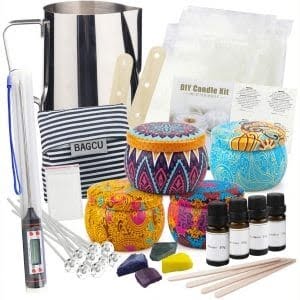Making candles wick going out is a common problem that many candle makers face. The wick plays a crucial role in the burning process of a candle, and understanding its significance is essential for successful candle making. In this article, we will explore the importance of the wick in candle making and provide valuable insights on choosing the right wick, preparing it for use, troubleshooting common issues, and maintaining it for optimal burn time.
The wick serves as the pathway for the melted wax to travel up to the flame, where it vaporizes and burns. Choosing the right wick for your candle depends on several factors such as the type of wax used, container size, and desired burn time. Preparing the wick correctly before placing it in the wax is also crucial to ensure a successful burn.
As we delve into this topic, we will address common reasons why candles wick goes out and provide alternative solutions to prevent this issue from recurring. Additionally, proper maintenance of the wick will be discussed to help extend the life and burn time of your candles.
Finally, safety tips will be provided to ensure an enjoyable and safe candle-making experience. Whether you are new to candle making or looking to improve your skills, understanding the role of the wick is fundamental to creating high-quality candles with consistent burning performance.
Choosing the Right Wick for Your Candle
When it comes to making candles, choosing the right wick is crucial to ensuring a successful burn. There are several factors to consider when selecting a wick for your candle, including the type of wax, the diameter of the candle, and the desired burn time.
The type of wax you use in your candle will greatly impact the choice of wick. For example, soy wax typically requires a different type of wick than paraffin wax. It’s important to do your research and select a wick that is compatible with the specific type of wax you are using.
In addition to considering the type of wax, you’ll also need to take into account the diameter of your candle. A larger candle will require a thicker wick in order to ensure an even burn, while a smaller candle may need a thinner wick. Choosing the right size wick will help prevent issues such as tunneling and uneven burning.
It’s also important to think about the desired burn time of your candle. If you want a longer burn time, you’ll need to choose a wick that can accommodate this. Conversely, if you want a shorter burn time, selecting a different type of wick will be necessary. By taking these factors into consideration, you can increase the chances of a successful burn without having to worry about your candles wick going out prematurely.
| Factor | Consideration |
|---|---|
| Type of Wax | Soy vs Paraffin wax requires different types of wicks |
| Candle Diameter | Larger vs smaller candles require thicker or thinner wicks respectively |
| Burn Time | Determine length or shortness depending on chosen wick |
Preparing the Wick
Choosing the Right Wick Size
The size of the wick plays a crucial role in how well your candle will burn. If the wick is too small, it may not be able to draw up enough wax to fuel the flame, causing it to go out. On the other hand, if the wick is too large, it can create a bigger flame than necessary and lead to tunneling or sooting.
To choose the right wick size, consider factors such as the diameter of your candle, the type of wax you are using, and any added fragrance or color. It’s important to do some testing with different wick sizes before settling on one for your candle-making project.
Trimming the Wick
Before lighting your candle, it’s essential to trim the wick to an appropriate length. A wick that is too long can cause excessive flickering and smoking, leading to an uneven burn and potential extinguishing of the flame. Ideally, the wick should be trimmed to around 1/4 inch before each use. This will help maintain a steady and efficient burn throughout the life of your candle.
Using Wick Centering Devices
When pouring hot wax into your container or mold, it’s important to keep the wick centered so that it remains straight during cooling. Using a wick centering device can help ensure that the wick doesn’t shift or tilt as the wax solidifies. This simple step can prevent issues such as off-center burning or a wandering flame, which could ultimately lead to the wick going out prematurely.
By paying attention to these tips for preparing the wick, you can set yourself up for a successful and enjoyable burning experience with your homemade candles.
Troubleshooting
When making candles, one of the most frustrating issues that can occur is the wick going out. There are several common reasons why this might happen, but understanding them can help you troubleshoot and prevent it from happening in the future.
One possible reason for your candles wick going out is that it may be too long. If the wick is too long, it will produce a larger flame that can consume the wax at a faster rate, causing the wick to burn out prematurely. Trimming the wick to the proper length before each use can help prevent this problem.
Another common reason for a candle’s wick to go out is an improperly sized wick. It’s important to choose a wick size that is appropriate for the diameter of your candle. Using a wick that is too small may not allow enough wax to be drawn up to fuel the flame, while using a wick that is too large can cause the flame to flicker and potentially burn out.
Additionally, drafts and air currents in the room where your candle is burning can also cause the wick to go out. If there is a breeze or air flow near your candle, it can disrupt the combustion process and lead to an extinguished wick. Finding a draft-free location for your candles or using a draft shield can help mitigate this issue.
| Common Reasons | Preventative Measures |
|---|---|
| Improperly sized wick | Choose appropriate size based on candle diameter |
| Wick too long | Trim wick before use |
| Drafts or air currents | Find draft-free location or use draft shield |
Proper Maintenance of the Wick
Maintaining the wick of your candles is essential for ensuring a longer burn time and a consistently strong flame. One key factor in maintaining your wick is trimming it to the appropriate length before each use. Over time, the wick can become too long, leading to a larger flame and faster burning. Trim the wick to about 1/4 inch before lighting your candle to prevent this from happening and to promote an even burn.
Another important aspect of wick maintenance is keeping it free from debris. As your candle burns, the wick will produce some amount of carbon buildup, also known as “mushrooming.” This can cause the wick to become unstable and lead to flickering or extinguishing. To prevent this, carefully remove any mushrooming from the tip of the wick before relighting your candle. This simple step can significantly extend the life of your candles.
In addition to regular trimming and cleaning, proper placement of the wick is crucial for optimal burn time. When pouring wax into your candle container, make sure that the wick is centered and straight. A misaligned or crooked wick can lead to uneven burning and may cause it to go out prematurely. By taking these maintenance steps into consideration, you can enjoy longer-lasting candles with consistent, steady flames.
Making candles with keeping going out requires careful attention to wick maintenance in order to ensure a long-lasting and enjoyable burning experience. Taking these steps will not only extend the life of your candles but also enhance their overall performance, giving you more value for the effort put into making them.
Alternative Solutions
When making candles, it can be frustrating to experience the wick continuously going out during the burn. However, there are various alternative solutions that can help rectify this issue and ensure a successful candle-making experience. By implementing these alternative solutions, you can troubleshoot the problem and prevent your wick from going out prematurely.
Check Wick Size and Type
One possible reason why your wick keeps going out is that it may not be the right size or type for the candle you are making. Ensure that you have chosen a wick that is suitable for the diameter of your candle and the type of wax being used. A wick that is too small can struggle to create a stable flame, while a wick that is too large can lead to excessive flickering and smoke.
Adjust Candle Design
Another alternative solution to consider if your wick keeps going out is to make adjustments to the design of your candle. For example, if you are using a container to make your candle, try increasing the size of the container or reducing any obstructions around the wick that may be affecting its ability to stay lit. Additionally, experimenting with different types of wax or adding additives such as stearic acid can also help improve the performance of your candle.
Use Wick Accessories
In some cases, utilizing wick accessories such as wick holders or centering devices can help keep your wicks in place and prevent them from going out prematurely. These accessories can provide additional support and stability to the wick during the burning process, ensuring a consistent and even burn throughout the life of the candle.
By implementing these alternative solutions, you can address the issue of your wick continuously going out when making candles. It’s important to troubleshoot and experiment with different techniques in order to find what works best for your specific candle-making process. With persistence and attention to detail, you can achieve successful burns and enjoy high-quality candles with long-lasting performance.
Safety Tips
When making candles, safety should always be a top priority to ensure an enjoyable and risk-free experience. Whether you are a seasoned candle maker or just starting out, it’s essential to adhere to safety guidelines to prevent accidents and ensure the well-being of yourself and those around you.
First and foremost, always work in a well-ventilated area when making candles. This helps to disperse any fumes that may be released during the melting of wax and the addition of fragrance oils. Additionally, having proper ventilation reduces the risk of inhaling potentially harmful chemicals and minimizes the chance of fire hazards.
Another important safety tip is to never leave melting wax unattended. It’s crucial to closely monitor the temperature of the wax and consistently stir it to prevent overheating, which can lead to fires or burns. Always keep a fire extinguisher within reach in case of emergencies, and know how to use it properly.
Furthermore, when handling hot wax and pouring it into candle containers, wearing protective gear such as heat-resistant gloves and aprons is highly recommended. This provides an extra layer of protection against accidental spills or splashes that could result in burns.
By following these safety tips, candle makers can minimize risks and focus on creating beautiful candles without compromising their well-being or that of others around them. Prioritizing safety while making candles with wick going out is vital for a successful candle-making experience.
Conclusion
In conclusion, understanding the importance of the wick in candle making is crucial for achieving a successful burn and extending the life of your candles. Choosing the right wick based on factors such as the type of wax and container size can greatly impact the performance of your candles. Additionally, preparing the wick properly by ensuring it is trimmed to the correct length and properly secured in the container can contribute to a more even and consistent burn.
When troubleshooting why a candle’s wick goes out, it’s important to consider common reasons such as drafts, an improperly sized wick, or poor quality wax. By addressing these issues and properly maintaining the wick through regular trimming and maintenance, you can extend both the life and burn time of your candles.
In instances where your wick keeps going out despite troubleshooting, there are alternative solutions to explore such as using a larger wick or incorporating additives into your wax. However, it’s essential to always prioritize safety throughout the entire candle-making process by following proper guidelines and precautions. By being mindful of these key points and taking proactive measures, you can ensure a safe and enjoyable candle-making experience while minimizing issues with wicks going out.
Frequently Asked Questions
How Do You Keep a Candle Wick From Going Out?
To keep a candle wick from going out, it’s important to trim the wick to 1/4 inch before lighting the candle. This helps the flame to stay steady and prevents it from flickering or extinguishing.
Why Do My Homemade Candles Keep Going Out?
Homemade candles may keep going out due to factors like an improperly centered wick, poor quality wax, or drafty environments. Ensuring the wick is properly centered and using high-quality materials can help prevent this issue.
How Do You Save a Drowning Wick?
If a candle wick is drowning and struggling to stay lit, one way to save it is by carefully pouring out some of the excess melted wax around the wick. This will help expose more of the wick and allow it to ignite properly.

Welcome to my candle making blog! In this blog, I will be sharing my tips and tricks for making candles. I will also be sharing some of my favorite recipes.





